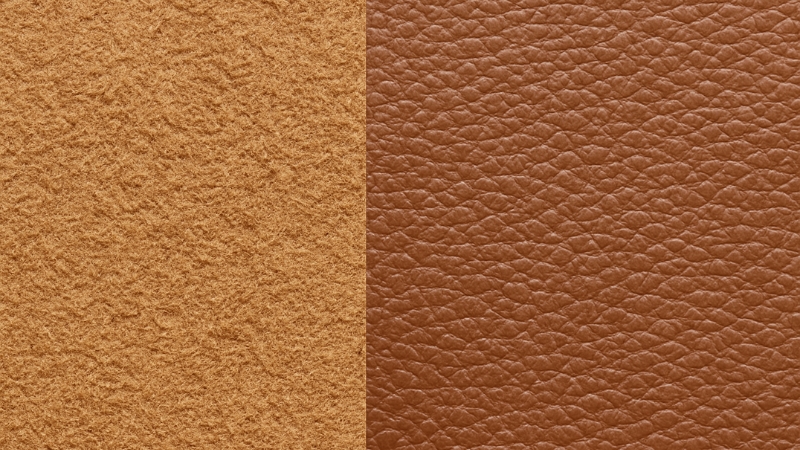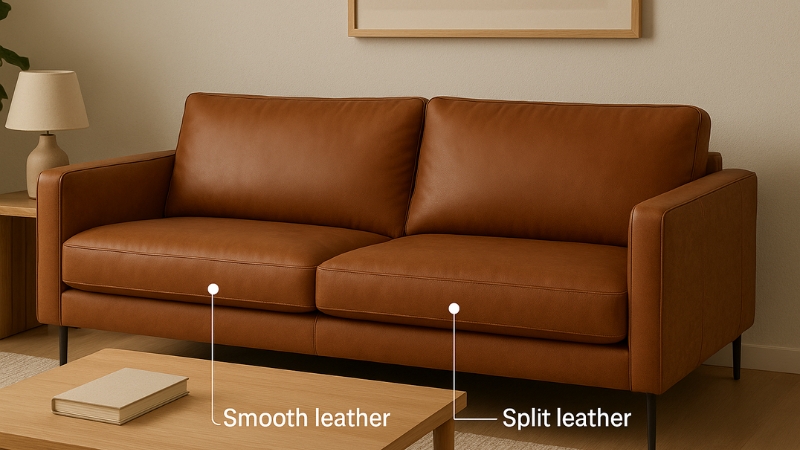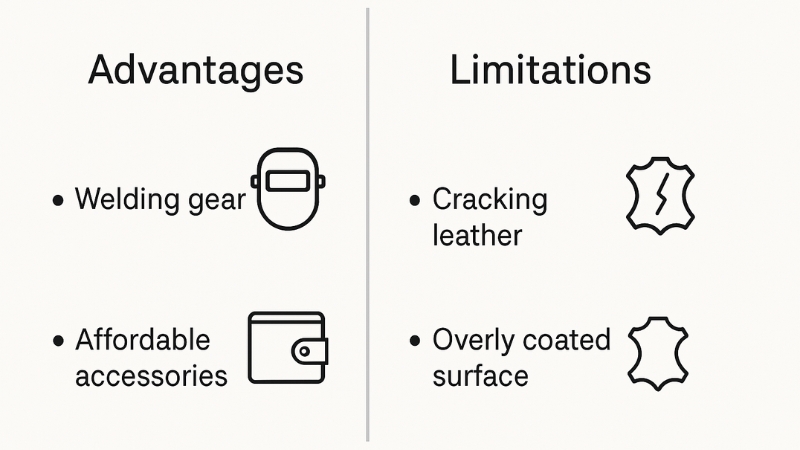Split leather is basically the lower layer of a hide, left after the smooth top-grain is removed. But let’s not get stuck on definitions. What really matters is what it can do.
This leather type shows up in welding jackets and aprons, handbags, belts, and wallets, and even car interiors and furniture accents. It’s soft, suede-like, and surprisingly durable for its price. With embossing or coating, split leather becomes versatile, protective, and stylish.
Read on to learn how, from industrial gear that shields sparks to everyday fashion accessories, split leather turns what could be scraps into practical, budget-friendly products.
Key Characteristics: Texture, Durability & Finishes
Before we dive into all the ways split leather gets used, it’s worth understanding what makes it unique. Split leather has its own personality—both strengths and weaknesses—that set it apart from other leather types.
Texture & Appearance
Split leather doesn’t have that smooth, natural grain you’ll find on top-grain or full-grain. Instead, it’s more fibrous and suede-like. Depending on how it’s finished, it can look velvety (like suede shoes) or be treated with embossing and coatings so it passes as grain leather.
Durability & Performance
Now, here’s where split leather earns its keep. While it’s not as tough as full-grain, it does offer decent abrasion and puncture resistance. That’s why you’ll see it in work gear like welding jackets and aprons—it can handle sparks and scrapes better than many fabrics. That said, it won’t age with that rich patina we love in high-end leather, and if it’s heavily coated, it can crack or peel over time.
Cost-Effectiveness
One of the biggest selling points of split leather is its affordability. Because it’s the byproduct of splitting hides, it’s far cheaper than top-grain or full-grain. That’s why it shows up in budget-friendly furniture, belts, and handbags—you get real leather without breaking the bank.
Recommended Read: Key Innovations Meant for Sustainable Leather Industry
Environmental & Ethical Angle
There’s also a sustainability perk here. Split leather ensures that more of the hide gets used instead of wasted. However, the environmental footprint still depends on the tanning and finishing process, which can involve chemicals.
So it’s a win in terms of reducing waste, but still something buyers should be aware of.
Popular Uses of Split Leather Products
Split leather might not carry the prestige of full-grain, but that doesn’t mean it’s sitting in the bargain bin of the leather world. In fact, it’s everywhere—sometimes in places you wouldn’t even guess.
The balance of affordability, decent durability, and versatility makes it a go-to material across fashion, furniture, cars, heavy-duty work gear, and even craft projects. Let’s break it down.
Fashion & Accessories
If you’ve ever picked up a genuine leather belt at a department store, there’s a good chance you were holding split leather. Fashion brands—especially those in fast fashion—love it because it keeps production costs low while still letting them slap the “real leather” label on products.
- Handbags & Wallets: You’ll see split leather handbags with embossed finishes that mimic top-grain. They look sharp, but they won’t age as gracefully.
- Belts & Shoes: Many affordable belts and casual shoes are crafted from split leather. They deliver that real-leather feel, but they won’t have the same long lifespan as higher-end alternatives.
Upholstery & Furniture
Split leather also sneaks into our living rooms. But here’s the trick: furniture makers rarely use it on the whole sofa. Instead, they’ll put split leather on the less-worn areas—like the back and sides—while saving top-grain or corrected grain for the cushions and armrests (the spots that get more abuse).
- Sofas & Chairs: That sleek “leather couch” might be a mix of split and top-grain, depending on where your body actually makes contact.
- Car Interiors: In automotive seating, split leather is often used in hidden or secondary areas like seat backs or paneling, while the surfaces you sit on get the premium treatment.
Automotive Trims
Cars are a perfect example of how split leather is used to stretch budgets while keeping up appearances.
- Door Panels & Headrests: Areas that don’t see much wear can get away with split leather since they’re mostly visual elements.
- Full-Leather Interiors (on a budget): Some budget trims advertised as all-leather may actually be part top-grain, part split. It looks cohesive, but it’s not all premium.
Recommended Read:What is Welding Leather: The Story of Leather Clothing for Safety
Industrial & Safety Gear
Now we’re talking about the heavy hitters—where split leather truly earns respect. Thanks to its abrasion resistance and ability to handle heat and sparks, split leather is a staple in protective workwear.
- Welding Aprons: These aprons are usually made of thick split cowhide, often stitched with Kevlar for added durability. They’re designed to take the brunt of sparks, slag, and heat.
- Welding Jackets: Full split-leather jackets are popular in metalwork and welding because they’re tough and fire-resistant, even if a bit stiff.
- Welding Gloves: Split leather gloves are thicker and rougher than their top-grain cousins, but they’re far better at resisting heat and wear in industrial environments.
Crafts & Small Items
Finally, split leather is a favorite among crafters and DIYers. Because it’s more affordable and often sold in scrap bundles, it’s perfect for small projects.
- Wallets & Key Fobs: Split leather can be embossed or dyed, making it versatile for small leather goods.
- Coasters & Desk Accessories: Easy to cut, stamp, and shape, split leather is often used in simple, practical projects.
- DIY Crafts: Hobbyists love it for practicing tooling and embossing without burning through expensive hides.
Bottom line: Split leather shows up everywhere—from your bargain-bin belt to the apron a welder trusts with their skin. It might not have the prestige of full-grain, but its versatility makes it a key player in fashion, industry, and even sustainable crafting.
Advantages vs. Limitations
Like every type of leather, split leather comes with its highs and lows. Let’s quickly break them down.
Advantages
- Affordable & versatile – It’s much cheaper than full-grain or top-grain, and can be embossed or coated to mimic more expensive finishes.
- Great for protection – In industrial gear like welding aprons or gloves, split leather does the job with heat and abrasion resistance.
- Efficient use of hides – Instead of wasting the underside of the hide, split leather ensures more of the animal skin is put to use.
Limitations
- Durability concerns – It can crack, peel, or lose flexibility if it’s heavily coated.
- Lacks character – Unlike full-grain, split leather doesn’t develop that rich patina over time.
- Can be misleading – Many genuine leather tags actually mean split leather, which can confuse buyers.
Crafting & Reuse Ideas
Split leather scraps don’t have to end up in the bin — they’re actually perfect for DIY projects and sustainable reuse.
Creative Projects from Scraps
Because split leather is softer and often comes in smaller, irregular pieces, it’s well-suited for compact goods and handmade crafts. Crafters often turn it into:
- Wallets & card holders – Durable enough for everyday carry, especially when lined or coated.
- Keychains & coasters – Simple cuts from scrap pieces make stylish, functional items (brands like Steel Horse Leather showcase this well).
- Bracelets & bookmarks – Easy beginner projects for those just learning leatherwork.
- Patchwork bags – Smaller pieces stitched together create a rugged, eco-friendly fashion accessory.
Split leather takes embossing and dye well, meaning you can add custom designs, patterns, or colors to personalize each project.
Reducing Waste
One of split leather’s biggest advantages is its eco-efficiency. Since it’s derived from the leftover underside of hides, reusing it prevents waste from the leather industry. When scraps are upcycled into new goods or recycled into bonded leather, it:
- Extends the life of materials that might otherwise be discarded.
- Reduces demand for new hides, lowering environmental strain.
- Promotes sustainable crafting for both small hobbyists and eco-conscious brands.
With proper sourcing and mindful reuse, split leather becomes less of a cheap alternative and more of a green material choice in the leather world.
FAQs About Split Leather
If you’re still scratching your head about split leather, you’re not alone. Let’s answer some of the most common questions buyers and DIYers have.
1. What makes split leather different from full-grain or top-grain?
Full-grain leather is the top layer of the hide—strong, breathable, and develops a beautiful patina over time. Split leather, on the other hand, comes from the fibrous underside. It’s softer, more uniform, and easier to emboss or coat, but it doesn’t age the same way. Think of it as functional and versatile, but without the luxury character of top-grain.
2. Can split leather be waterproofed?
Yes—but there’s a trade-off. You can apply waterproofing sprays or leather conditioners to add protection, but heavily treated split leather may feel stiffer or less natural. Light, frequent treatments work best to preserve flexibility.
3. Is split leather real leather?
Absolutely. Split leather is real leather—it’s just lower on the hide and doesn’t have the top-grain layer. As GentCreate explains, it’s a legitimate material with its own set of strengths and ideal applications.
4. How can I tell if a product is made from split leather?
Check the label – split leather, genuine leather, or corrected leather usually indicates split leather. The surface may feel softer and look uniform, and embossed finishes are common.
5. Can split leather be dyed or embossed?
Yes! In fact, it’s often treated this way to mimic full-grain leather. You’ll see it in different colors, patterns, and textures, which makes it popular for handbags, shoes, and accessories.
6. Is split leather suitable for heavy-duty use?
Yes, but selectively. While it’s not as strong as full-grain, thick split leather works well in industrial gear like welding jackets, gloves, and aprons, where heat and abrasion resistance are key.
7. Does split leather develop a patina over time?
Not like full-grain leather. Split leather can darken slightly with use, but it won’t get the same rich, character-filled patina. Coatings may also limit natural aging.
Why Split Leather Is a Smart Choice for Versatile Use
Split leather may not be full-grain, but it’s affordable, versatile, and practical—perfect for fashion, furniture, automotive trims, industrial gear, and DIY projects. Its durability in heavy-duty uses and adaptability in crafts make it a go-to material for budget-conscious buyers and makers.
Knowing its strengths—like abrasion resistance—and limitations—like less patina development—helps you choose fit-for-purpose split leather products and get the most value from them.





